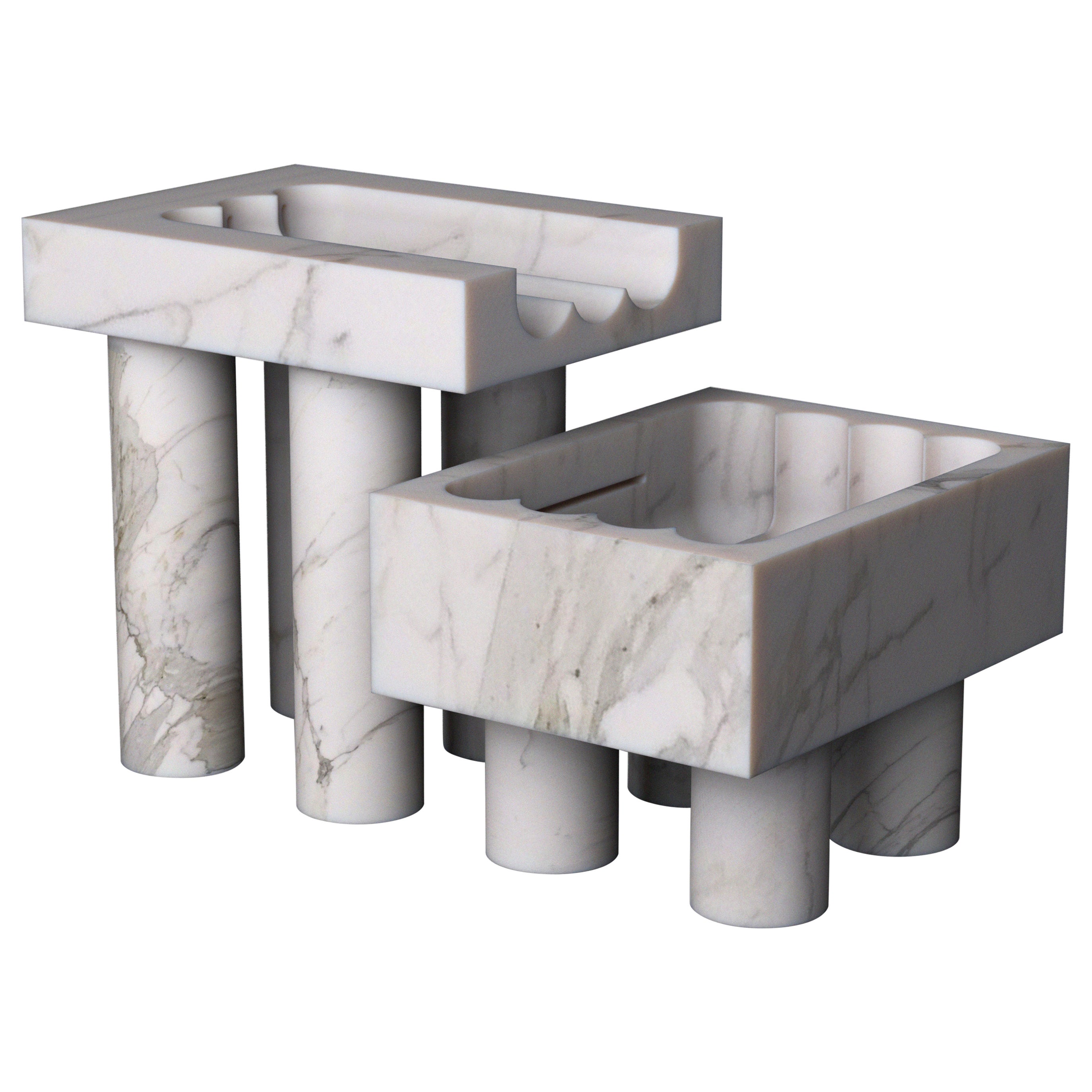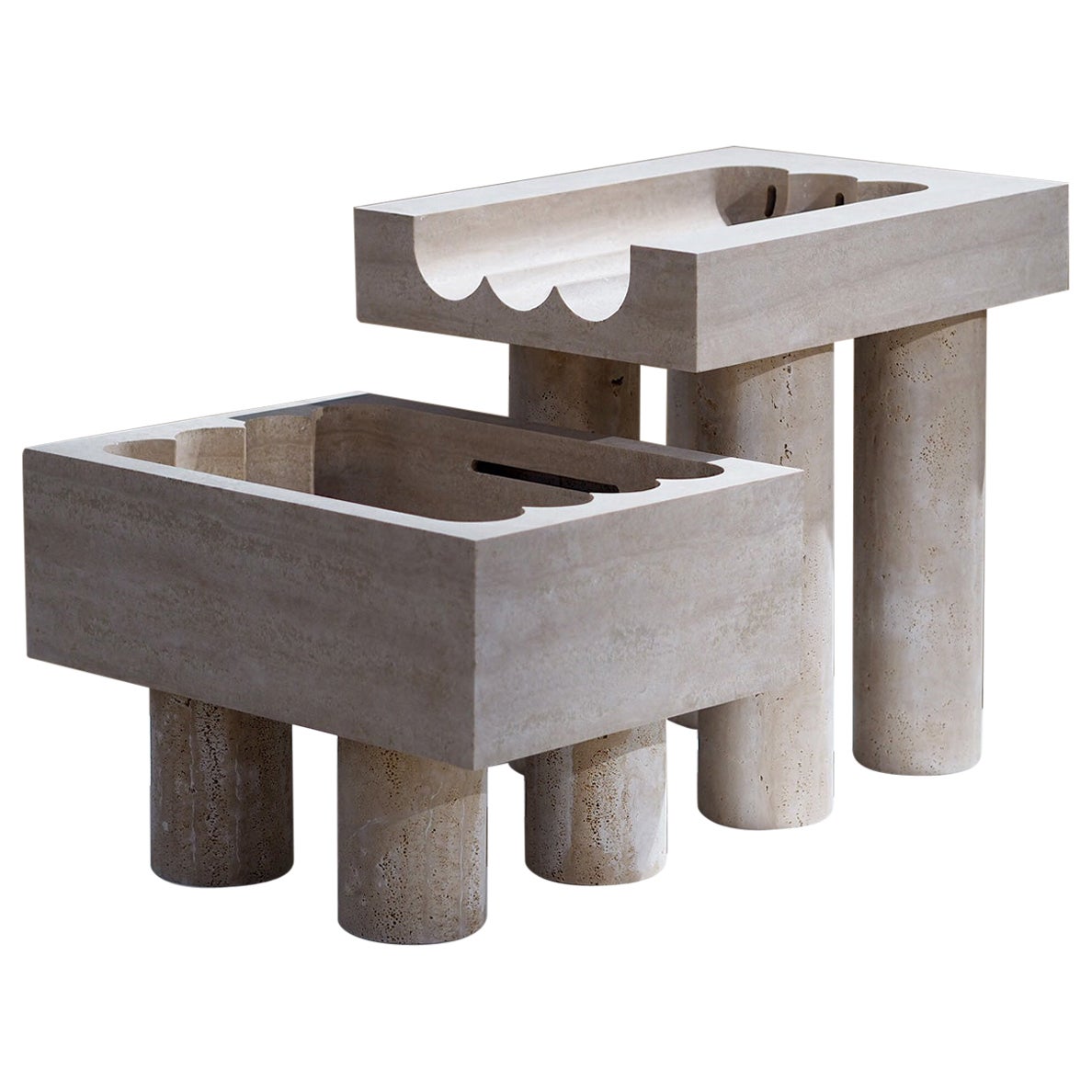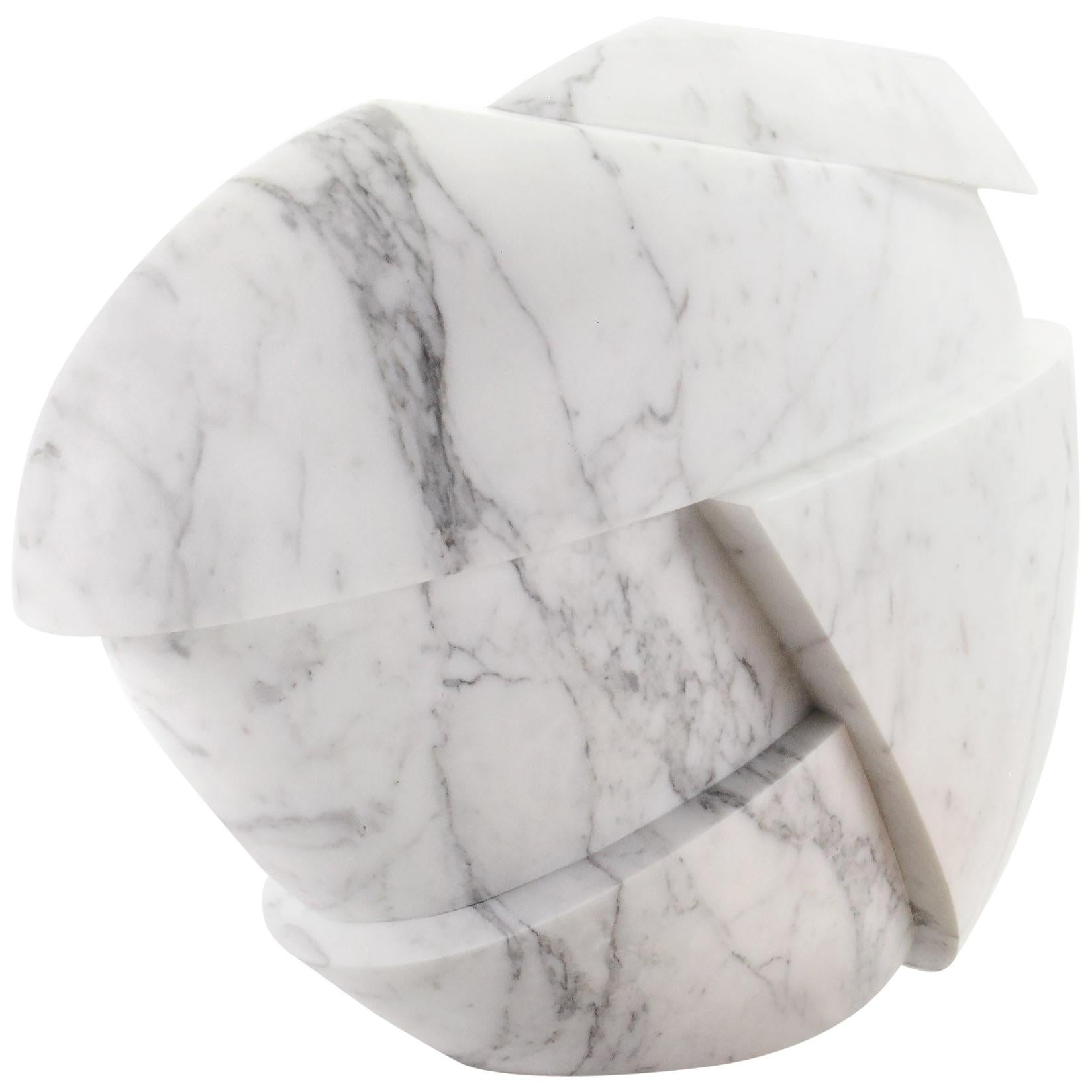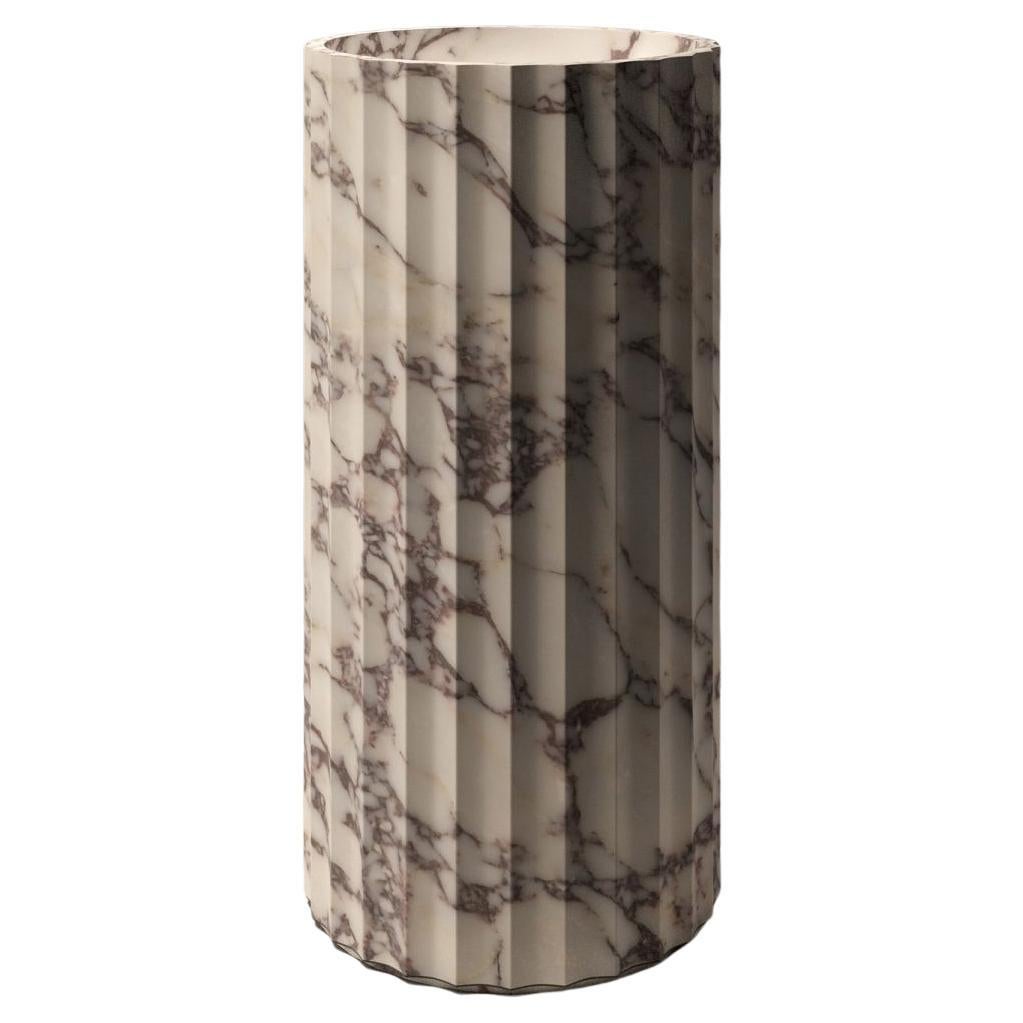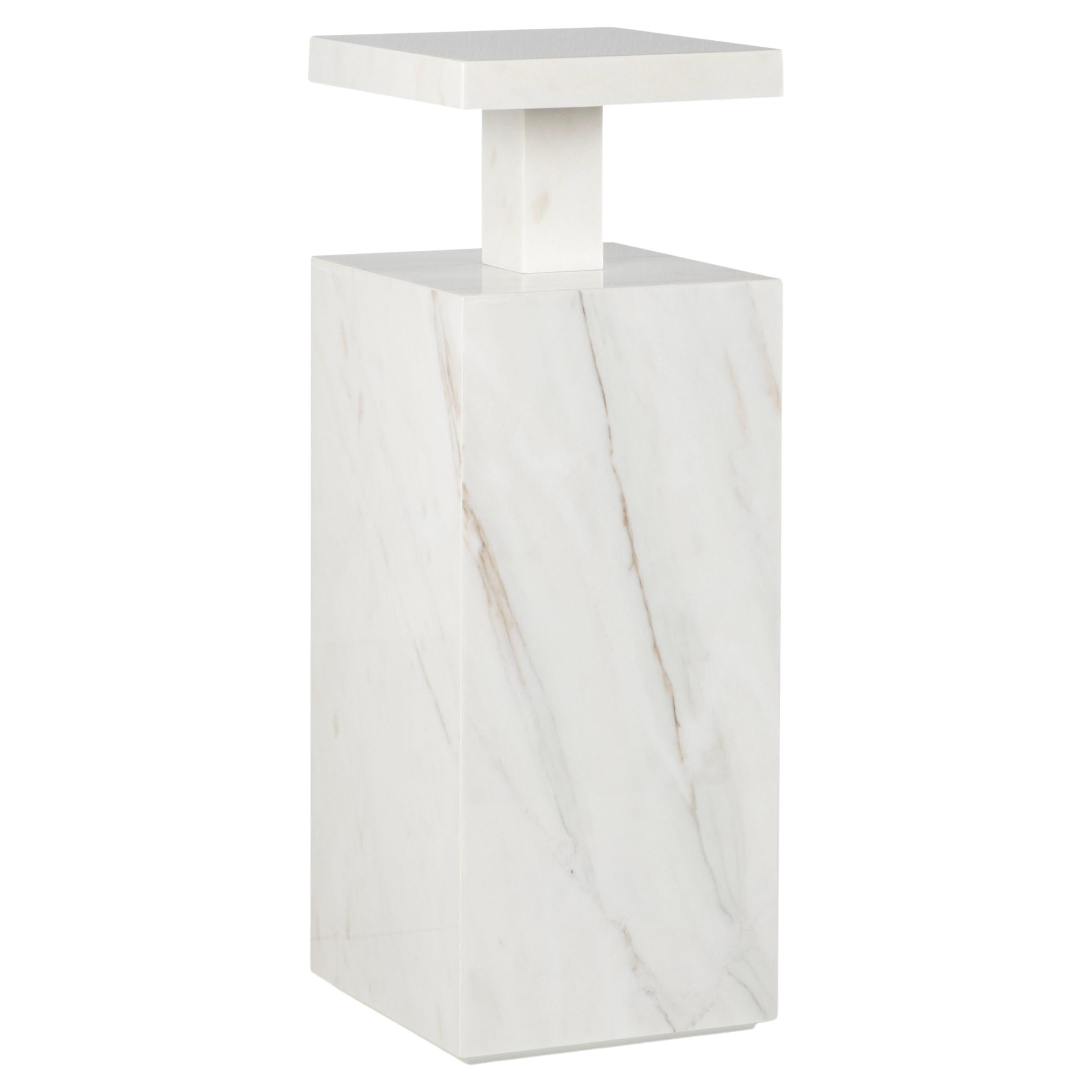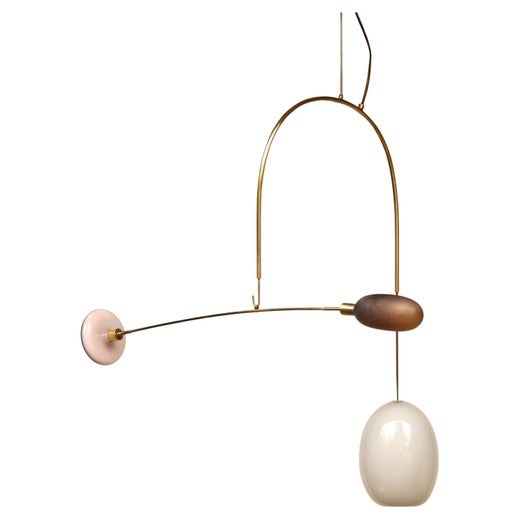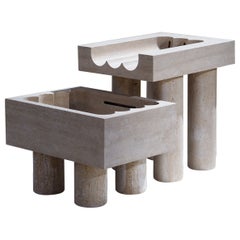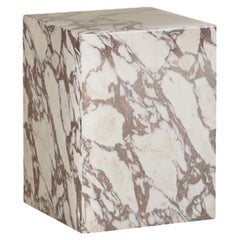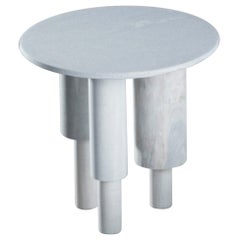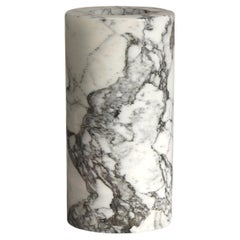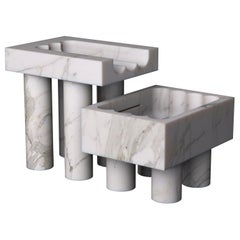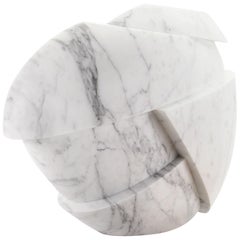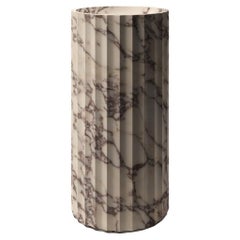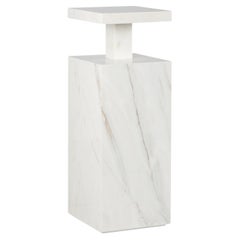Items Similar to Calacatta Marble Monolithic Font by Tino Seubert
Want more images or videos?
Request additional images or videos from the seller
1 of 6
Calacatta Marble Monolithic Font by Tino Seubert
$22,869.63per item
£17,120.41per item
€19,110per item
CA$31,482.91per item
A$34,416.99per item
CHF 18,208.14per item
MX$411,854.63per item
NOK 231,672.40per item
SEK 212,072.65per item
DKK 145,594.67per item
Quantity
About the Item
Calacatta marble Monolithic font by Tino Seubert.
Dimensions: D 100.5 x W 61 x H 62.1 cm.
Materials: Calacatta marble.
Tino Seubert
When he first made his now signature wicker and aluminium stools and benches in 2018 for a show at the Hepworth Gallery in Wakefield, German-born (1986, Forchheim), London-based Tino Seubert found that they opened up a whole new design philosophy for him. They became the starting point for his future projects, which all revel in the juxtaposition of the organic and the industrial and enjoy the exploration of unconventional contexts. For Seubert, the organic is often a welcoming entry point into his work, with people from different countries drawn in by familiar traditional craft elements, only to be tantalised by the clash with sleek, precise industrial design. As a designer, he thrives off an energetic participation in the processes that go into making his pieces: whether it’s wood and stonework or metal machining, electronics or anodising aluminium by hand, Seubert is always obsessively engaged with the detail of his creations.
- Dimensions:Height: 24.45 in (62.1 cm)Width: 24.02 in (61 cm)Depth: 39.57 in (100.5 cm)
- Style:Post-Modern (Of the Period)
- Materials and Techniques:
- Place of Origin:
- Period:
- Date of Manufacture:2022
- Production Type:New & Custom(Current Production)
- Estimated Production Time:7-8 weeks
- Condition:
- Seller Location:Geneve, CH
- Reference Number:Seller: TSHT1stDibs: LU1219234201622
Galerie Philia
Galerie Philia is an international contemporary sculptural design and art gallery representing emerging and established designers and artists. The gallery is the brainchild of two brothers who share a lifetime passion for art, literature and philosophy. Their distinct academic background sets them apart from their peers, as it sees them following a rhizomatic and transcultural approach in the way they select works. This involves combining elements from multiple cultures in what becomes a network of harmoniously interconnected roots, ultimately revealing the beauty of each unique creation. The gallery’s non-hierarchical curation sits apart from the ephemerality of trends and focuses instead on the true aesthetic quality of the piece – alluring and timeless. Unlike others, Galerie Philia does not focus on a single style – whether minimalist, organic or raw – but rather embraces heterogeneity. The Galerie Philia takes pride in discovering new talents, providing them with multiple international platforms to showcase their latest creations. As well as propelling the newest generation of 21st century collectible design, Galerie Philia also works with internationally known design artists. Galerie Philia has a strong international presence, with galleries in Geneva, New York and Singapore. In addition to their permanent spaces, the gallery organizes temporary group exhibitions and artists residencies in first-class locations around the world.
Made-to-order creations can be done, please contact us for any request.
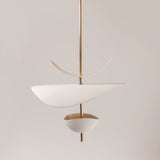
About the Seller
5.0
Recognized Seller
These prestigious sellers are industry leaders and represent the highest echelon for item quality and design.
Diamond Seller
Premium sellers with a 4.7+ rating and 24-hour response times
Established in 2015
1stDibs seller since 2015
5,162 sales on 1stDibs
Typical response time: <1 hour
- ShippingRetrieving quote...Shipping from: -, United Kingdom
- Return Policy
More From This Seller
View AllRoman Travertine Monolithic Font by Tino Seubert
Located in Geneve, CH
Roman Travertine Monolithic font by Tino Seubert
Dimensions: D 100.5 x W 61 x H 62.1 cm.
Materials: Roman Travertine.
Tino Seubert
When he first made his now signature wicker a...
Category
2010s British Post-Modern Figurative Sculptures
Materials
Travertine
$19,446 / item
Coi Calacatta Viola Pillar by Un’common
Located in Geneve, CH
Coi Calacatta Viola Pillar by Un’common
Designed by Małgorzata Korycka.
Dimensions: D 32 x W 32 x H 42 cm.
Materials: Calacatta Viola marble.
COI is a minimalist and elegant piece o...
Category
2010s Polish Post-Modern Statues
Materials
Marble
$4,427 / item
Tall Game of Stone Marble Center Piece by Josefina Munoz
Located in Geneve, CH
Tall game of stone marble center piece by Josefina Munoz
Game of Stone Collection.
Dimensions: H 12 x Ø 20cm.
Material: marble Palissandro Blu Nuvolato.
Also available in low cen...
Category
2010s Swiss Post-Modern Centerpieces
Materials
Marble
Sky Vase in Arabescato Marble by Paloma Editions
Located in Geneve, CH
Sky Vase in Arabescato Marble by Paloma Editions
Dimensions: D 18 x W 18 x H 35 cm.
Materials: Arabescato marble.
Hand-carved from a single block of stone. All edges are smoothed ov...
Category
2010s Italian Modern Vases
Materials
Marble
$4,739 / item
Three-dimensional Flat Surface White Stone Column Pedestal by Frédéric Saulou
By Frederic Saulou
Located in Geneve, CH
Arch Buffon marble column pedestal by Frédéric Saulou
Limited edition: 1 / 12
Designer: Frederic Saulou
Materials: Ornemental Limestone Buffon.
Dimensi...
Category
2010s French Organic Modern Pedestals and Columns
Materials
Stone
Carrara Marble Evoluzione Sculptural Console by Atelier Terrai
Located in Geneve, CH
Carrara Marble Evoluzione Sculptural Console by Atelier Terrai
Dimensions: D 35 x W 150 x H 85 cm.
Materials: Carrara marble.
This sculpture is engraved from a solid block of white ...
Category
2010s Italian Post-Modern Console Tables
Materials
Carrara Marble
You May Also Like
Monolithic Font - Two part fountain carved from Calacatta Marble
By Tino Seubert
Located in London, GB
Originally designed in Travertine for Wallpaper* Magazine's annual Handmade exhibition at the Salone del Mobile 2017, Tino Seubert teamed up with Pibamarmi to create a two-levelled i...
Category
2010s British Modern Fountains
Materials
Marble, Carrara Marble
Vase Vessel Decoration Sculpture White Statuary Marble Geometric Hand-carved
By Barberini & Gunnell, Pieruga Marble
Located in Ancona, Marche
Important sculptural vase carved by hand from a solid block of Statuary marble.The precious white Statuary marble has always been the one preferred by sculptors and artists for their...
Category
21st Century and Contemporary Italian Modern Vases
Materials
Marble
"Delfi" Pedestal Sink Made of Calacatta Viola Marble
By Atelier Pibamarmi
Located in Beverly Hills, CA
Crafted in exquisite Calacatta Viola marble, this Piba Marmi pedestal is a unique expression of nature's beauty and versatility. The intricate detailing of the fluted surface showcas...
Category
21st Century and Contemporary Italian Modern Stone Sinks
Materials
Marble
Modern Monique Column, Calacatta Marble, Handmade in Portugal by Greenapple
By Greenapple, GF Modern
Located in Lisboa, PT
Modern Monique Column, Handcrafted in Portugal - Europe by Greenapple.
The Monique marble column, carved from exquisite Calacatta Cremo marble, embodies timeless sophistication. Wit...
Category
21st Century and Contemporary Portuguese Modern Pedestals
Materials
Statuary Marble, Quartz, Onyx, Carrara Marble, Marble, Travertine
FORM(LA) Grinza Pedestal 16"L x 16"W x 24"H Calacatta Viola Marble
Located in Los Angeles, CA
A BOLD AND EXPRESSIVE FORM WHERE GEOMETRY AND HARMONY COLLIDE. ITALIAN FOR WRINKLE, 'GRINZA'S ZIG-ZAG STRUCTURE' IS BOTH TIMELESS AND ELEGANT.
DIMENSIONS (PEDESTALS SOLD INDIVIDUAL...
Category
21st Century and Contemporary American Organic Modern Pedestals and Columns
Materials
Travertine, Marble
FORM(LA) Grinza Pedestal 16"L x 16"W x 40"H Calacatta Viola Marble
Located in Los Angeles, CA
A BOLD AND EXPRESSIVE FORM WHERE GEOMETRY AND HARMONY COLLIDE. ITALIAN FOR WRINKLE, 'GRINZA'S ZIG-ZAG STRUCTURE' IS BOTH TIMELESS AND ELEGANT.
DIMENSIONS (PEDESTALS SOLD INDIVIDUAL...
Category
21st Century and Contemporary American Organic Modern Pedestals and Columns
Materials
Travertine, Marble
Read More
Galerie Philia Unveils Limited-Edition Designs at Giampiero Tagliaferri’s New L.A. Studio
For the exhibition “Materia Perpetua,” the gallery asked an international group of makers — including Tagliaferri — to explore the possibilities of a surprisingly versatile material: onyx.
Galerie Philia Doesn’t Just Discover Fresh Design Talent — It Grows It
With an impressive slate of international exhibitions, the Geneva-based gallery raises the profiles of emerging designers.
More Ways To Browse
Tall Plinth
Wpa Sculptures
Antique Drawing Cabinet
Bronze Boat
Centaur Sculpture
Glazed Ceramic Pumpkin
Hand Painted Chinese Porcelain Figurines
Inuit Sculptures
Lladro Figurines Used
Marble Base Statue
Pagoda Sculpture
Painted Mannequin
Polychrome Wood Statue
Roman Fragment
Rosario Vintage
Sculpture Of Michelangelo
Snake Charmer
Spanish Furniture 15th Century
